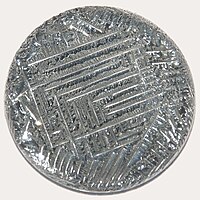
Photo from wikipedia
Abstract Bismuth titanate nanoparticles were prepared by the anodic spark conversion route and the effects of electrolyte’s constituents on the electrochemical process were studied. The experimental results showed that the… Click to show full abstract
Abstract Bismuth titanate nanoparticles were prepared by the anodic spark conversion route and the effects of electrolyte’s constituents on the electrochemical process were studied. The experimental results showed that the anodic oxidation initiate the conversion of bismuth to bismuth trioxide, which was further transformed into bismuth titanate. By diversifying the amount of NaOH and H2O2 in the electrolyte, the phase formation, the optical property and photocatalytic ability of bismuth titanates can be well-manipulated. Pure selinite-type Bi12TiO20 with size of ca. 10 nm can be prepared in an electrolyte containing 0.8 M NaOH and 0.4 M H2O2, exhibiting better UV–vis adsorption ability and higher photocatalytic activity compared with the bulk one.
Journal Title: Optik
Year Published: 2017
Link to full text (if available)
Share on Social Media: Sign Up to like & get
recommendations!